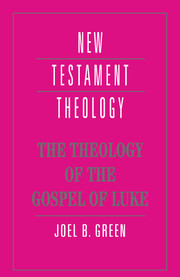Book contents
- Frontmatter
- Contents
- Editor's preface
- Preface
- List of abbreviations
- 1 “In the days of King Herod of Judea”: the world of Luke's Gospel
- 2 “God my Savior”: the purpose of God in Luke's Gospel
- 3 “A Savior, who is the Messiah, the Lord”: Jesus, John, and the Jewish people
- 4 “To proclaim good news to the poor”: mission and salvation
- 5 “Let them take up the cross daily”: the way of discipleship
- 6 “That you may know the truth”: Luke's Gospel in the church
- Further reading
- Index of biblical texts
- Index of modern authors
- Index of subjects
4 - “To proclaim good news to the poor”: mission and salvation
Published online by Cambridge University Press: 05 June 2012
- Frontmatter
- Contents
- Editor's preface
- Preface
- List of abbreviations
- 1 “In the days of King Herod of Judea”: the world of Luke's Gospel
- 2 “God my Savior”: the purpose of God in Luke's Gospel
- 3 “A Savior, who is the Messiah, the Lord”: Jesus, John, and the Jewish people
- 4 “To proclaim good news to the poor”: mission and salvation
- 5 “Let them take up the cross daily”: the way of discipleship
- 6 “That you may know the truth”: Luke's Gospel in the church
- Further reading
- Index of biblical texts
- Index of modern authors
- Index of subjects
Summary
It has become axiomatic in studies of Luke that Jesus' sermon at Nazareth (4:16–30) is programmatic for our understanding of the mission of Jesus in the Gospel. Its importance is suggested by a number of factors. First, unlike the other Synoptic Evangelists (Matt. 13:53–58; Mark 6:1–6), Luke has located Jesus' ministry in Nazareth not in the midst of the Galilean ministry but at its beginning. Indeed, following lengthy anticipations and preparations (1:5–4:13), this is the first scene of Jesus' public ministry. Here are his first spoken words in the Gospel. Second, although it was customary for Jesus to attend the synagogue and teach on the Sabbath (4:15, 16, 31–37, 44; 6:6; 13:10–17), nowhere else do we hear of the content of his teaching. Consequently, his message here serves as an exemplar of his synagogue teaching more generally. Third, summaries of Jesus' ministry in Luke–Acts refer back to this episode as paradigmatic for our understanding of Jesus' vocation (7:18–23; Acts 10:38). Finally, the content of Jesus' message at Nazareth is as momentous as is its setting at the onset of his public ministry. In these words the shape of Jesus' ministry in the Third Gospel is given form. What is this message?
Some interpreters have hoped to find the key to understanding this pericope by taking with utmost seriousness its intertextual relationship to the Isaianic material. This is surely true along general lines, but one must also account for the fact that the Isaianic citation is, in Luke 4:18–19, already re-interpreted. This is true both because of its new narrative setting within the Lukan narrative but also because it is not a word-for-word citation.
- Type
- Chapter
- Information
- The Theology of the Gospel of Luke , pp. 76 - 101Publisher: Cambridge University PressPrint publication year: 1995
- 1
- Cited by



